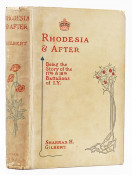(these books are located in the USA)
Engraved frontispieces in each volume, engraved plates and engravings in the text, folding map, original publisher's cloth. Mild signs of age to mainly early pages and plates, yet still a nice, rare set. Notice how clean most of this set's engravings on plates are, especially when compared to other sets. Both volumes canted.
"[Alexander] proceeded to Namaqualand and Damaraland, which countries were very little known at the time. Leaving Cape Town in 1836, he traversed these regions in an ox wagon, and went through a large part of South West Africa arriving at Walvisch Bay almost exhausted with the difficulties of travel and want of water. He succeeded in obtaining a good collection of zoological and other specimens, many of which were at that time unknown to the scientific world. The volumes contain an account of the social condition of the Namaquas, Bushmen and Damaras." -- Mendelssohn
---------------------------------
From S2A3 Biographical Database of Southern African Science:
|
|||
|
James Edward Alexander was the son of Edward Alexander of Powis and his wife Catherine Glas. He was educated at the Universities of Edinburgh and Glasgow, and at the Royal Military College in Sandhurst, Berkshire, England. He became a cadet in 1820, at the age of 17, and was a professional soldier for his entire career. He served in the first Anglo-Burmese War as a cornet in 1824, was promoted to lieutenant in 1825, fought with the Persian army against Russia in 1826, and in the Russo-Turkish War in 1829, and was decorated by both Persia and Turkey. After his promotion to captain in 1830 he fought in Portugal during 1832-1834, and explored the Essequibo River in Guyana, South America. He came to the Cape of Good Hope in January 1835 and served as aide-de-camp to Sir Benjamin D'urban during the Sixth Frontier War of 1835. The campaign was described in detail in his Narrative of a voyage of observation among the colonies of Western Africa ... and of a campaign in Kaffirland... (London, 1837, 2 vols). In this same year (1837) he married Eveline Marie Michell, daughter of Colonel C. C. Michell*, Colonial Engineer and Surveyor-General at the Cape. At a meeting of the Cape of Good Hope Association for Exploring Central Africa on 19 March 1836, upon the return of Dr Andrew Smith's* expedition into the interior, Alexander was elected a member of the association's new management committee and remained a member for many years, even after having left South Africa. He had been invited by the Royal Geographical Society to explore the interior of southern Africa from Delagoa Bay, but Smith's successful expedition caused him to change his objective to the western interior. His expedition was of considerable scientific interest, even though Alexander was not a trained scientist. He left Cape Town on 10 September 1836, traveling northwards to the Cederberg, where he found fossils in the foothills. From Leliefontein, in the Kamiesberg, he wrote to the Royal Geographical Society ("Latest intelligence from Captain Alexander", Journal, 1837), describing the country as far north as the Orange River, with particular attention to Rooiwalbaai and Alexander Bay (which was later named after him). He was shown rich copper ore some 30 km south of the Orange River and, believing that there was much more to be found, suggested that it might be transported to the river by wagon and then by boat to its mouth. However, no economically viable copper deposits have been found in this area. Crossing the river at Ramans Drift on 24 November 1836 he proceeded to Warmbad, in what is now Namibia, explored part of the Karras Mountains, and reached the Fish River late in February 1837. In its valley he discovered an unusual quantity of iron meteorites. Reaching Walfish Bay in April 1837 he proceeded along the Kuiseb River and eastwards to the vicinity of Rehoboth where he met Chief Jonker Afrikaner. He then turned south because of inadequate water supplies and reached the Fish River again early in June. After crossing the Orange at Goodhouse at the end of July he reached Cape Town on 21 September 1837. He left for England at the end of October. The new finds among his collection of birds from Damaraland were described by G. Waterhouse in 1838. One of his outstanding discoveries was the White-tailed shrike, Lanioturdus torquatus, collected in the Naukluft Mountains. His collections also included some 300 plant specimens, which were presented to Cambridge University, and he was commemorated in the name of the Rattle tree, Catophractes alexandri. The land snail Dorcasia alexandri was also named after him. His "Report of an expedition of discovery through the countries of the Great Namaquas, Boschmans, and the Hill Damaras in South Africa" was published in the Journal of the Royal Geographical Society (1838). A more comprehensive account was published that same year: An expedition of discovery into the interior of Africa, through the hitherto undescribed countries of the Great Namaquas, Boschmans, and Hill Damaras... (Philadelphia, 1838, 2 vols). He was knighted in recognition of his achievements (1838) and is regarded as the first scientific explorer of Namibia. |
|||
- Size: 8vo










































